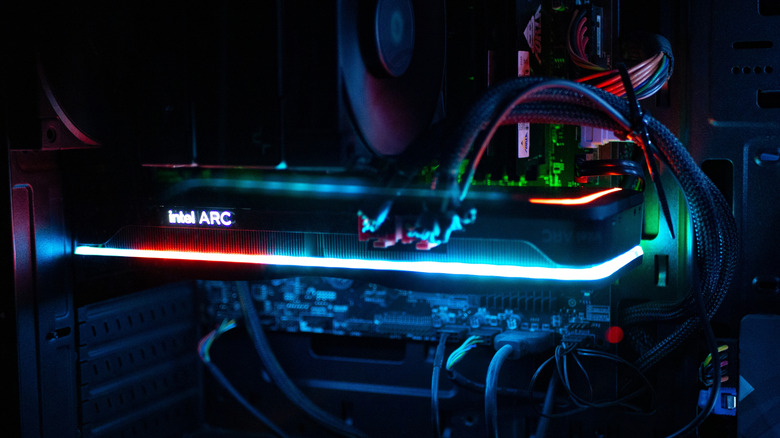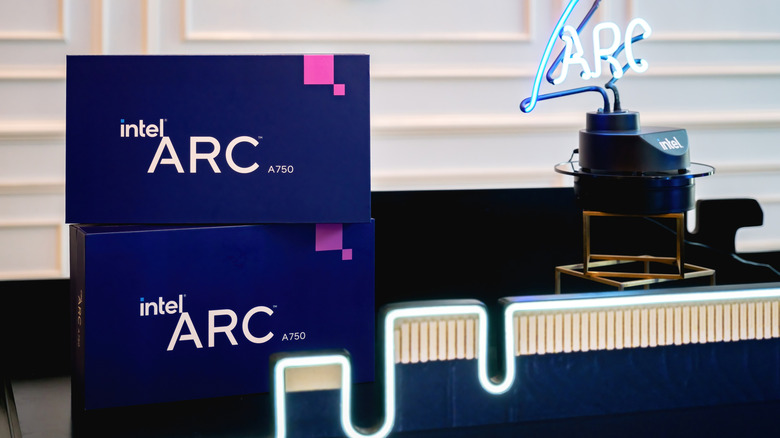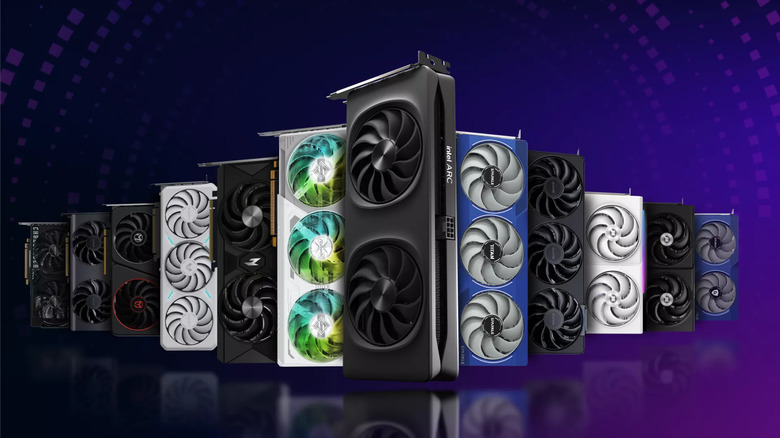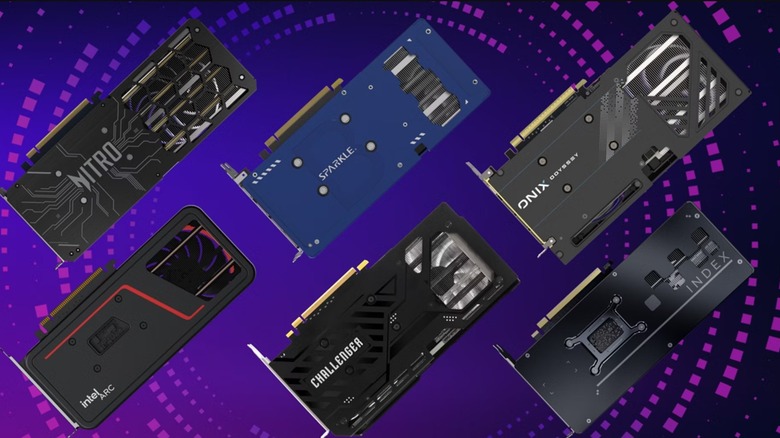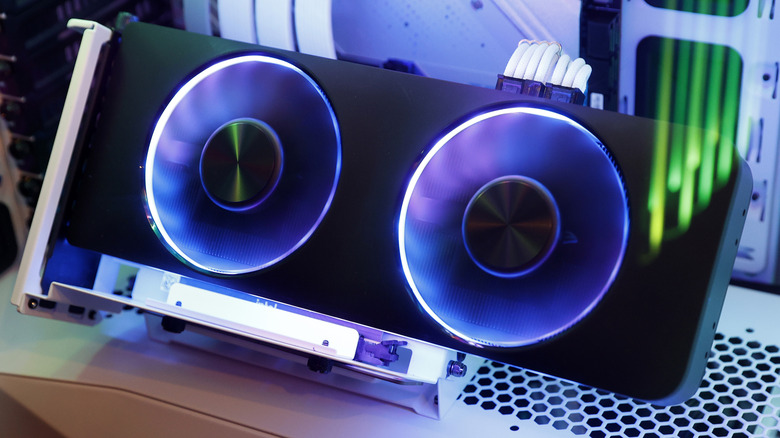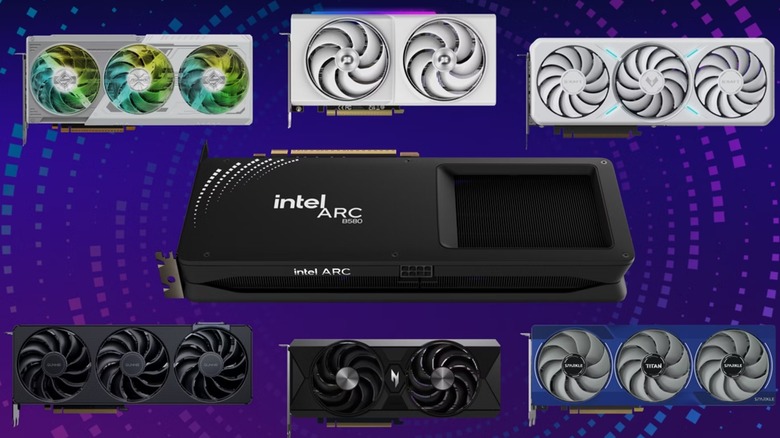Are Intel GPUs As Good As Nvidia And AMD? Here's What Users Have To Say
We may receive a commission on purchases made from links.
When it comes to discrete graphics cards, the two brands that immediately spring to mind are Nvidia and AMD. However, Intel also has a horse in this race, all thanks to its two generations of GPUs: Intel Arc Alchemist and Arc Battlemage. If you're not sure whether Intel GPUs are as good as their Nvidia and AMD rivals, I'll do my best to give you a clear overview of both, based on user insights and reputable benchmarks.
Tech aficionados and casual users alike are often wary when faced with a new product. Everyone knows Intel for some of the best processors, but graphics cards? Sure, Intel's responsible for integrated graphics in millions of PCs, but it's still new to the world of discrete GPUs — and that's a tough place to be in. PC and laptop enthusiasts usually go for better graphics, which means that Intel is effectively a small fish in a big pond filled with very well-versed tech-loving piranhas.
It doesn't help that, at least at first, Intel's Arc Alchemist had its fair share of issues, including performance and driver problems. Now, with the second generation of Intel's discrete GPUs out in full swing, is Intel on an even playing field with Nvidia and AMD? Let's break this down based on performance, specs, price, stability, and availability, based on opinions from real users as well as my own experience as a PC hardware journalist with over a decade of experience.
Are Intel GPUs stable now?
For some necessary context, Intel Arc Alchemist had a rough start. The launch of these GPUs was delayed time and time again, and then, the drivers weren't ironed out the way many people expected them to be. The cards ran great when newer, DirectX 12 games were being played, but older titles struggled sometimes. Intel's engineering team put in a lot of work following the launch of Arc Alchemist, and for the most part, the cards were stabilized as complaints about their performance quieted down.
Going into the second generation of Intel GPUs, many worried about the state of the drivers, but everyone also knew that Intel had done a lot of work on the software side, so the expectation was that Battlemage would run better. I had a bit of hands-on time with the Arc B580 following its launch, and found little to complain about. In fact, we ranked it among the top 3 GPUs under $300.
In various Reddit threads, most users agree that Arc Battlemage is largely stable now. One user admits that the drivers "aren't as fleshed out as Nvidia or AMD yet," but also says they have had no issues despite trying many different games. Another person claims that the drivers have been solid and receive frequent updates. However, some users note that it depends on the game, and there are still some kinks to work out. Meanwhile, another thread has people bringing up concerns like high idle power draws or limited GPU tuning options. Some users report various other driver problems in the r/IntelArc Reddit community, but the general consensus seems to be that the drivers have improved.
How do Intel GPUs perform when compared with Nvidia and AMD?
To answer the question of Intel vs. Nvidia and AMD, I'm going to focus solely on the Arc B580 and B570. While the Arc A770 (which was Intel's top GPU in the previous generation) managed to make waves, it's comparable to cards that are now two gens old. Meanwhile, the B580 competes against cards from one generation ago. It's hard to predict just how good it is when compared to Nvidia's recent RTX 5060, but we do know where to place it when compared to the RTX 4060 as well as the AMD Radeon RX 7600: It's on par with both, according to sources such as the Tom's Hardware GPU Hierarchy.
When ray tracing is thrown into the mix, the Arc B580 actually outperforms its last-gen AMD equivalents in benchmarks. Tom's Hardware reviewed the card and found that it beat the Arc A770, RTX 4060, and RX 7600 XT at 1440p with ray tracing enabled. All the cards offered frame rates lower than what can be considered playable, but still, that's a major win for Intel Arc, which is still only in its second generation.
What do users have to say? Much the same thing. One Redditor said that Intel really nailed it when it comes to entry-level gaming GPUs. Another said that the hardware that Intel provides is "the best by a landslide in that price range." Users repeatedly point out good value as one reason to buy Intel, which is what we'll dive into next.
Intel vs. AMD vs. Nvidia: Which brand makes the cheapest GPU?
Now that we've established how the Intel Arc Battlemage lineup stacks up against AMD and Nvidia competitors, let's talk about value. This generation contains some of the worst price-to-performance graphics cards, all because of the state of the market. With many graphics cards selling above their recommended list price (MSRP), the performance-per-dollar aspect is drastically altered — and that's a shame, since this is where Intel truly shines.
At launch, the Intel Arc B580 was priced at $249 and the Arc B570 at $219, undercutting the competition by a significant margin. The comparable RTX 4060 was priced at $299, and AMD's RX 7600 started at $269. But, according to benchmarks, the Arc B580 can trade blows with AMD's RX 7600 XT, which started at $329. If we follow the launch pricing and nothing else, it's clear that the B580 was a great value pick, and this was reflected in various reviews.
The reality at the time of writing is different, and might be different still by the time you read this article. The Intel Arc B580 currently sells for over $370 on Amazon, while Nvidia's RTX 5060 — faster than the B580, plus with access to DLSS 4 — sits at $300. At these prices, the value-for-the-money aspect is no longer the same. Many Redditors point out that the card is good value at $250, but buying it above $300 invalidates those claims.
Availability-wise, we're looking at around the same situation across all cards, but there aren't many models of the Arc B580 currently in stock. If Intel could provide better availability, the price might have dropped, but right now, the demand still seems to be too high for retailers to keep up with.
Where does Intel win?
Despite the (currently) inflated price, many users and reviewers alike remark on some important wins for Intel. The stability, while sometimes called into question, definitely seems to be improved from the rocky launch of Intel's first-gen discrete GPUs. But the biggest win for Intel lies in one, very important specification: Video memory, or VRAM.
Having plenty of VRAM is important for a graphics card, especially one that's made for gamers. Video RAM stores and manages the data your graphics card needs to render images and videos. Increasingly, we're seeing top-of-the-line games calling for more memory, and that's because they're packed full of high-quality textures that push your GPU to the limit. Unfortunately, many mainstream cards are quite short on VRAM, and while they're fine today, they might be less fine in a few years from now. Nvidia's RTX 4060 has 8 GB VRAM, as does AMD's RX 7600.
Meanwhile, both the Intel Arc B580 and the B570 offer up more memory spread across a wider interface, meaning more bandwidth. The B580 serves up 12 GB VRAM, while the B570 offers 10 GB, both of which are sizeable upgrades that help to future-proof the GPUs further.
Are Intel Arc GPUs worth buying right now?
According to user opinion, Intel Arc Battlemage graphics cards are worth buying, but the MSRP is the caveat here. Spending close to $400 on one of these GPUs puts you within range of cards like the RTX 5060 Ti 16 GB, which are a great deal faster. If the B580 sells at its intended price, though, it provides excellent value.
Having tested the card myself a few months ago, I was impressed with how much it could carry at 1080p. Gaming was smooth and seamless, and I can imagine that now, months after launch, many early issues will have been worked out. However, users still sometimes complain about crashes and lower performance in certain titles, but there's no telling if that can ever be completely avoided.
If you want a mainstream GPU that offers good value, the Arc B580 is a good option if bought under $300. Otherwise, you're better off saving more money for a more powerful card or waiting until the market and stock levels begin to stabilize.
Methodology
In order to provide an unbiased look at Intel Arc graphics cards, I relied on a few different sources. I have scoured Reddit for posts related to the Arc B-series, including the B580 and the B580. I visited the r/IntelArc community to read user impressions and complaints. I also drew comparisons to the launch of Arc Alchemist and the user reactions that those GPUs received.
In addition, I turned to reputable benchmarks from established publications. Benchmarks give a good overview of where a GPU should land in the grand scheme of things, and they add more weight to Intel's own claims about the performance of its latest cards. For prices, I checked Amazon, Newegg, and Best Buy.
Lastly, as a PC hardware journalist with a decade of experience, I relied on my own impressions of the B580, which I've had the chance to briefly test in March 2025 in a setup that included AMD's Ryzen 7 7800X3D and 32GB of RAM. As my main focus is the graphics card market at large, I remain up to date with all current releases and the way they perform.
